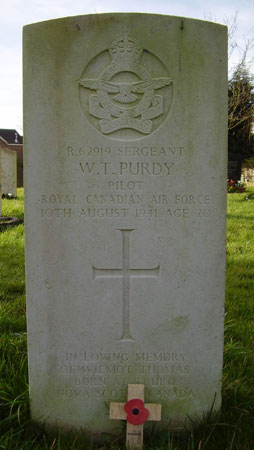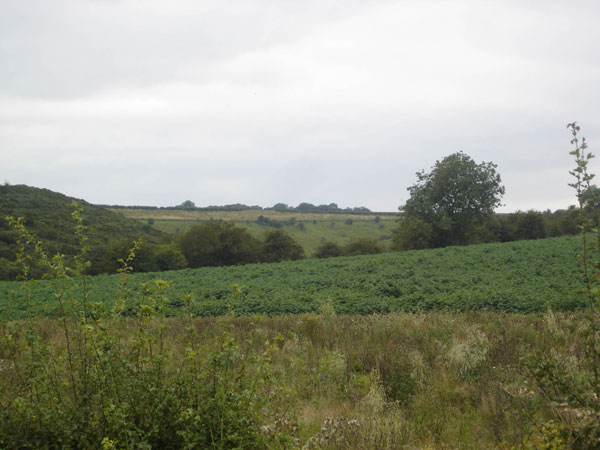Spitfire R7133 near Sledmere.
On 10th August 1941 the pilot of this 129 Squadron aircraft had take off from Leconfield for a local flying training flight that involved a degree of formation flying, he was flying at 6,000 feet as part of the formation of three when the aircraft broke away from the formation, rolled onto it's back and dived into the ground at around 12.00hrs. Sadly the pilot was killed in the crash. The reason for this accident was not known when the webpage was last updated.
Pilot - Sgt Wilmot Thomas Purdy RCAF (R/62919), aged 20, of Truro, Nova Scotia. Buried Leconfield Churchyard, Yorkshire.
Sgt Purdy's grave in Leconfield churchyard. He was born on 18th May 1921 at Truro, Nova Scotia, Canada and was the son of Wilmot Wardwell and Myrtle Jessie (Mingo) Purdy. As a young man he worked on a family farm and studied agriculture at the Nova Scotia Agricultural College. He enlisted for RCAF service on 20th September 1940 and following training in Canada he was awarded his pilot's flying badge on 22nd April 1941. He arrived in the UK in May 1941 and after training at 57 OTU was posted to 129 Squadron on 28th July 1941, but arrived on 1st August 1941. As a well as having a grave in Leconfield, Yorkshire he is commemorated on a family memorial at Truro, Nova Scotia. His younger brother Carl David Purdy also served in the RCAF in WW2.
Aviation historians Rodney Robinson, Albert Pritchard and Ken Reast obtained permission from the landowner to track this crash site down in April 2006 and were able to find small pieces from the aircraft on the surface to confirm the location, shown on the hillside in the photograph below.
Ken Ward appears to have dug the site possibly before Rodney's group visited, Mr Ward recovered a number of items including one of the two cockpit rudder pedals with the distinctive "Supermarine" logo shown above which he allowed me to photograph in 2010.

Spitfire R7133 was built to contract B.19713/39 by Vickers Armstrong's (Supermarine) Ltd at Eastleigh/Woolston and was first test flown on
15th February 1941. It was flown into storage at Kirkbride on 7th March 1941 at 12 MU where it stayed until 22nd June 1941 it was taken on
charge by 129 Squadron. It arrived at 129 Squadron at Leconfield the following day, this was only days after the unit formed. As a result of the incident near Sledmere on 10th August 1941 Cat.E2/FA Burnt damage was recorded and
it was struck off charge ten days later when the paperwork went through.

